Modeling Methane Emission from Wetlands in North-Eastern New South Wales, Australia Using Landsat ETM+
Abstract
:1. Introduction
2. Materials and Methods
2.1. Study Area
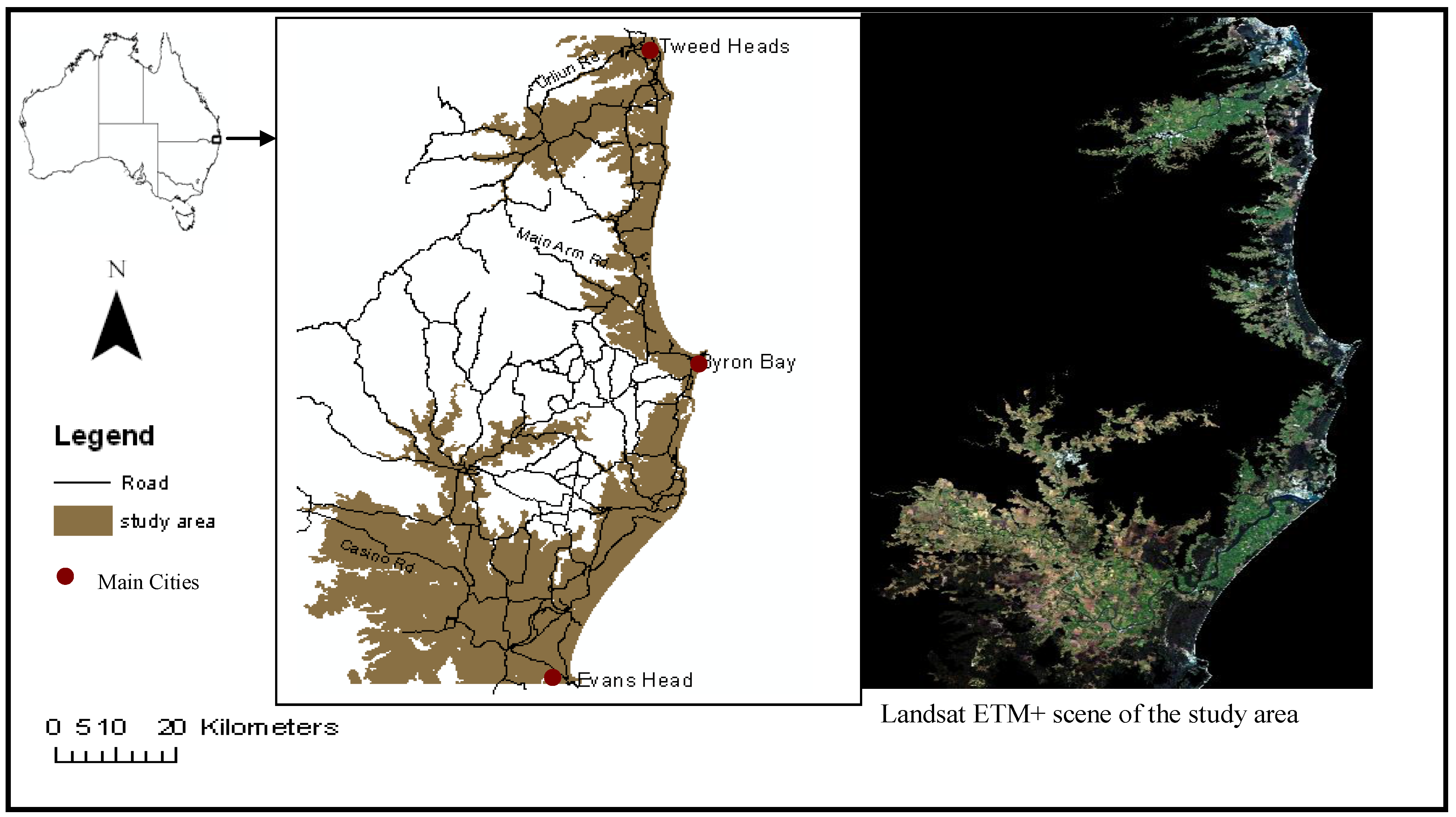
2.2. Satellite Data
| Bands | Spectral range (Microns) | Spatial resolution |
| Band 1 | 0.45–0.52 | 30 × 30 m |
| Band 2 | 0.52–0.60 | 30 × 30 m |
| Band 3 | 0.63–0.69 | 30 × 30 m |
| Band 4 | 0.76–0.90 | 30 × 30 m |
| Band 6 | 10.40–12.50 | 60 × 60 m |
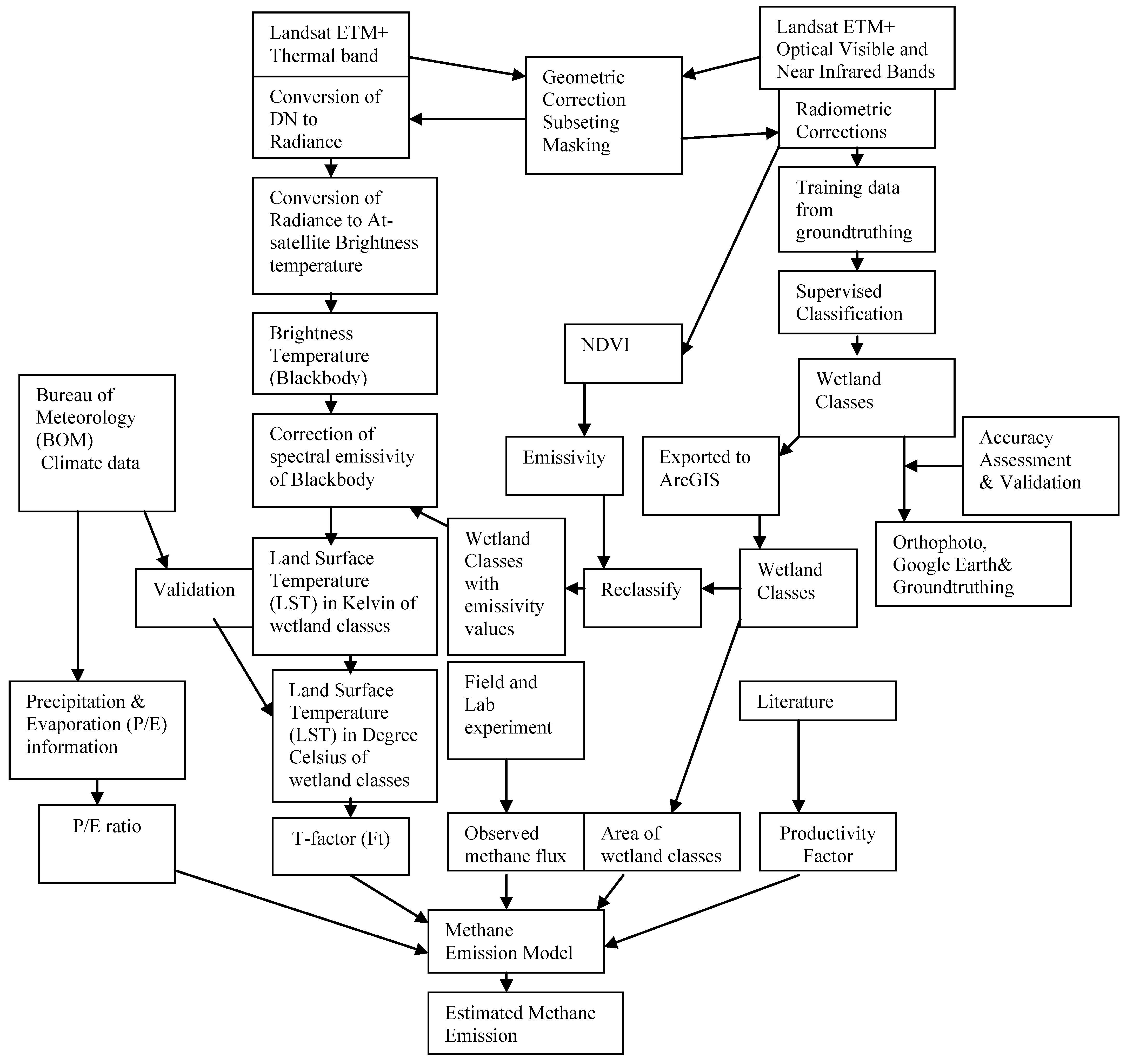
2.3. Methane Emission Estimation
- ECH4 = Estimated Methane Emission
- A = Area of wetland classes
- Ft = T factor
- Eobs = observed methane flux from different wetland classes,
- P = Productivity factor
- fw = P/E = Precipitation /Evaporation ratio, Where: fw {P/E if P ≤ E} or {1 if P > E}.
2.3.1. Estimating Area of Methane Emitting Wetlands
2.3.1.1. Conversion of DN to Radiance-Landsat ETM+
- Lrad = Spectral radiance, W/m2/sr/µm
- DN = Digital number.
| Bands | Gain | Bias |
| 1 | 0.7756863 | −6.1999969 |
| 2 | 0.7956862 | −6.3999939 |
| 3 | 0.6192157 | −5.0000000 |
| 4 | 0.6372549 | −5.1000061 |
2.3.1.2. Conversion of Radiance to Reflectance—Landsat ETM+
- RTOA: the planetary reflectance
- Lrad: is the spectral radiance at the sensor’s aperture;
- π: ≈ 3.14159
- ESUNi: the mean solar exoatmospheric irradiance of each band
- d = (1 − 0.01672 × COS (RADIANS (0.9856 × (Julian_Day − 4)))).
- z: solar zenith angle (zenith angle = 90 − solar elevation angle), solar elevation angle is within the header file of the satellite images.
2.3.1.3. Classification
2.3.2. Estimating T factor
- Ft = T factor
- Ts = Land surface temperature in Degrees Celsius
- = Mean of F (Ts) over wetlands. It was derived from the F (Ts) image. The F (Ts) image was converted from raster to vector format in ArcGIS and their mean values estimated.
2.3.2.1. Estimating Land surface Temperature (Ts)
Conversion of Digital Number (DN) to Spectral Radiance
- L λ = radiance, W/m2/sr/µm
- DN = digital number
Conversion of Spectral Radiance to At-Satellite Brightness Temperature (Blackbody temperature)
- TB = at-satellite temperature in Kelvin
- L λ = spectral radiance W/m2/sr/µm
- K2 and K1 are pre-launch calibration constants. For Landsat-7 ETM+
- K2 = 1,282.71 K
- K1 = 666.09 mW cm−2 sr−1 μm−1.
- ε = emissivity
- NDVI = Normalized Difference Vegetation Index.
- St = emissivity corrected land surface temperatures (LST) in Kelvin
- λ = wavelength of emitted radiance,
- ρ = h × c/σ (1.438769 × 10−2 m K, second radiation constant), σ = Boltzmann constant (1.3806503 × 10−23 J/K), h = Planck’s constant (6.626068 × 10−34 J s), c = velocity of light (2.99792 × 108 m/s).
- TB = at-satellite temperature in Kelvin
- ε = emissivity of wetland classes
| Wetland classe | LST (°C) | T °C from BOM | Projected LST (°C) assuming 1 °C rise in mean annual temperature by the year 2030 |
| Mangroves and saltmarshes | 12.23 ± 0.64 | 12.98 ± 0.56 | 13.23 ± 0.64 |
| Forested wetlands | 10.78 ± 0.51 | 10.56 ± 0.61 | 11.78 ± 0.51 |
| Coastal swamps | 11.77 ± 0.78 | 11.11 ± 0.72 | 12.77 ± 0.78 |
| Estuarine water bodies | 14.13 ± 0.72 | 15.23 ± 0.69 | 15.13 ± 0.72 |
| Coastal upland water bodies | 12.85 ± 0.79 | 12.12 ± 0.70 | 13.85 ± 0.79 |
| Dunal wetlands | 12.22 ± 0.75 | 13.31 ± 0.54 | 13.22 ± 0.75 |
2.3.3. Methane Flux
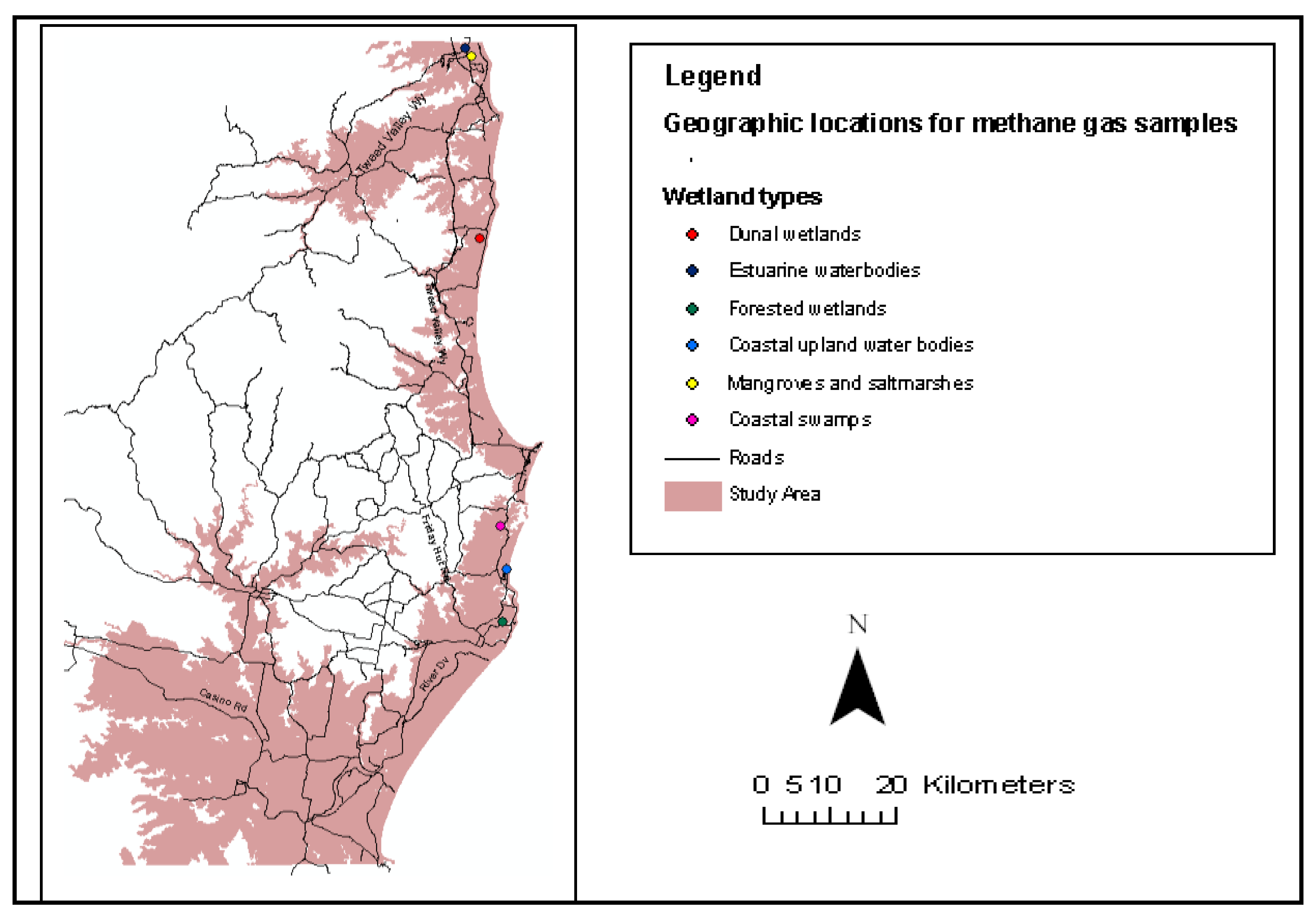
2.3.4. Productivity Factor
- R = Productivity factor
- NPP = Net primary productivity.
2.3.5. Precipitation and Evaporation Ratio
3. Results
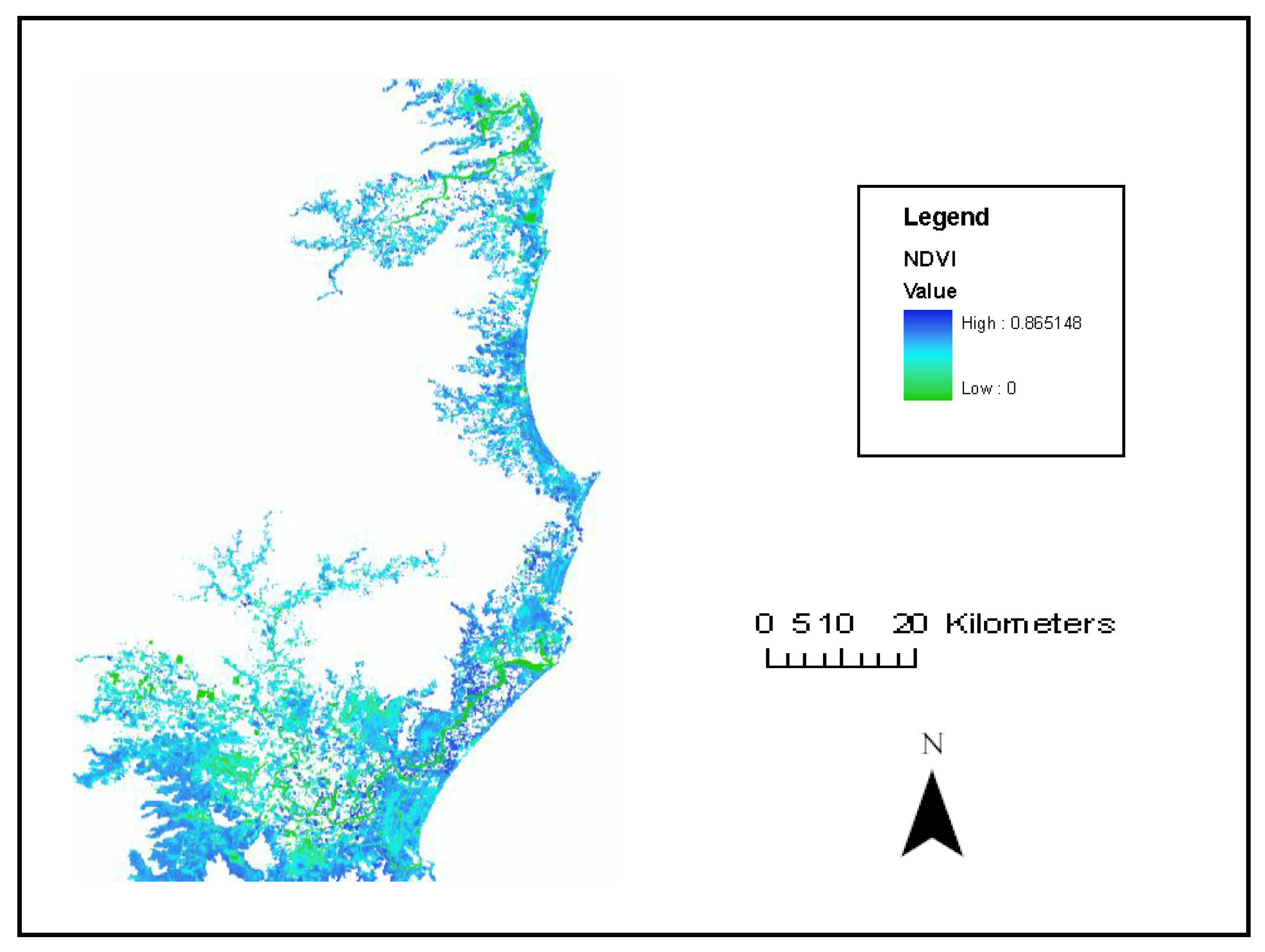
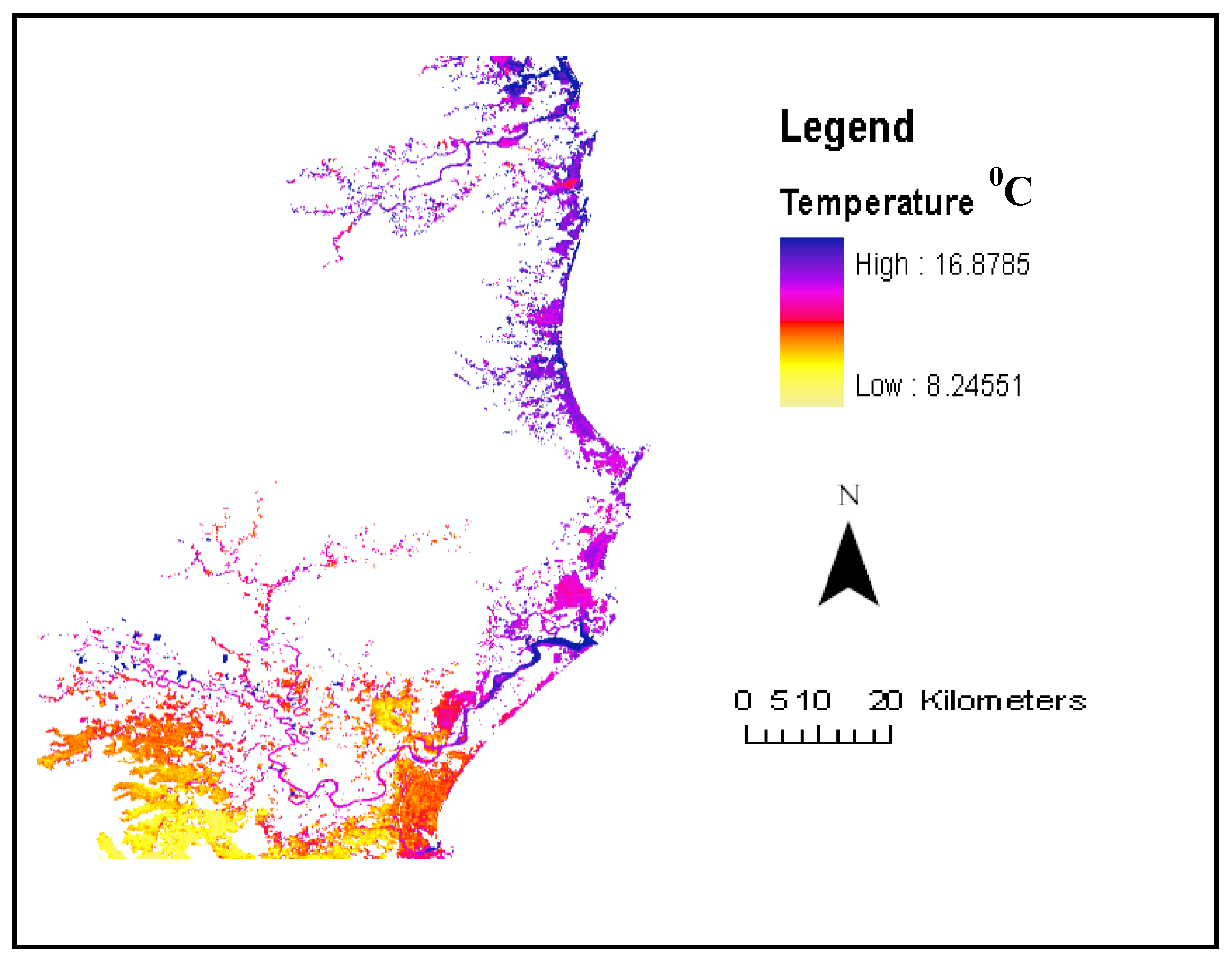
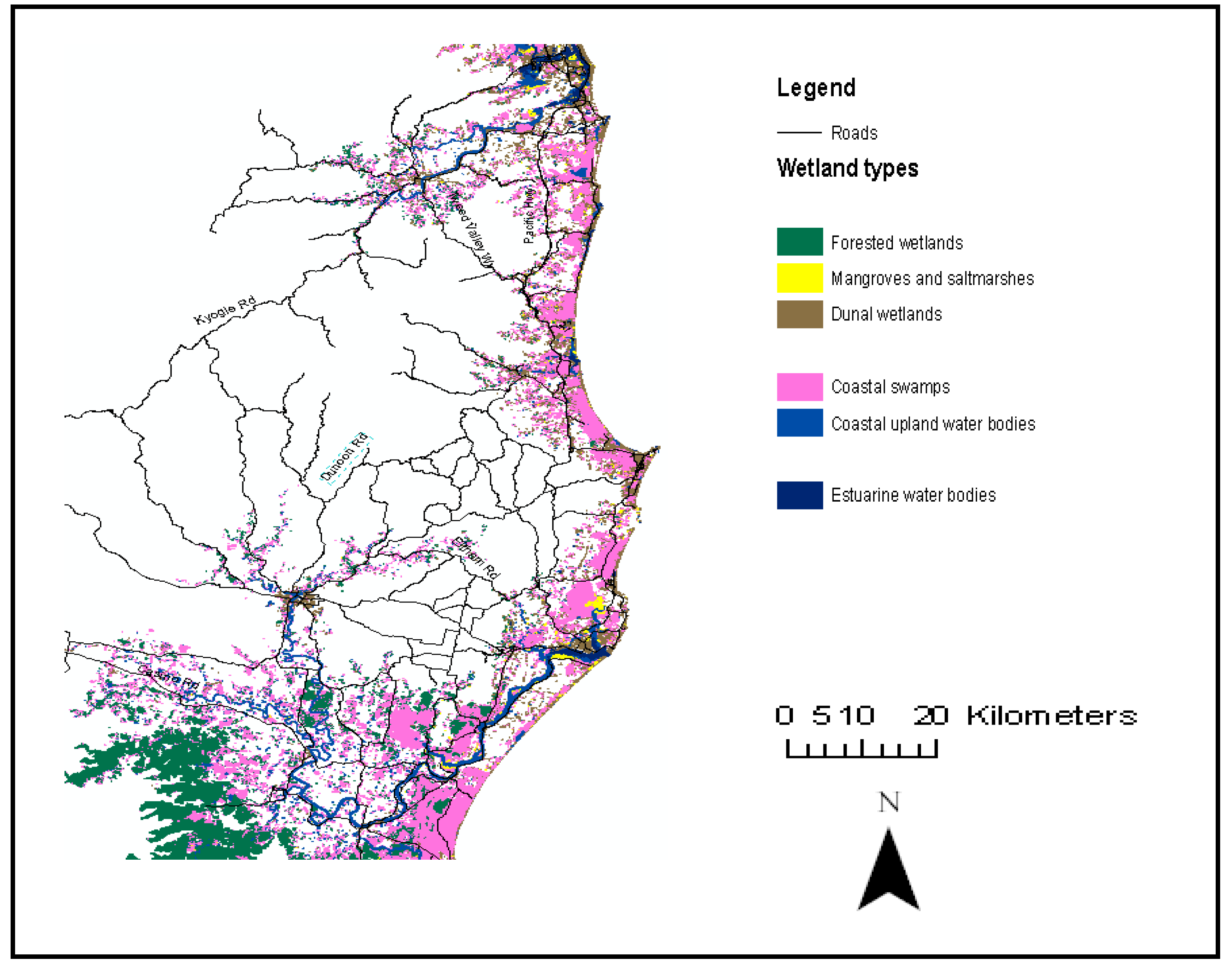

| Wetland | T factor | Projected T factor-assuming 1 °C rise in mean annual temperature by the year 2030 |
| Mangroves and saltmarshes | 0.69 ± 0.15 | 0.96 ± 0.20 |
| Forested wetlands | 0.45 ± 0.08 | 0.64 ± 0.12 |
| Coastal swamps | 0.57 ± 0.16 | 0.80 ± 0.22 |
| Estuarine water bodies | 1.03 ± 0.25 | 1.44 ± 0.34 |
| Coastal upland water bodies | 0.71 ± 0.19 | 0.99 ± 0.26 |
| Dunal wetlands | 0.70 ± 0.18 | 0.98 ± 0.25 |
| Wetland class | Mean Flux ± SE (g/m2/day) | Mean Flux ± SE (g/m2/month) | Number of gas samples |
| Mangroves and saltmarshes | 0.016 ± 0.01 | 0.496 ± 0.32 | 16 |
| Forested wetlands | 1.029 ± 0.01 | 31.286 ± 2.97 | 16 |
| Coastal swamps | 0.161 ± 0.05 | 4.893 ± 1.44 | 16 |
| Estuarine water bodies | 0.022 ± 0.0001 | 0.683 ± 0.004 | 16 |
| Coastal upland water bodies | 0.015 ± 0.004 | 0.461 ± 0.13 | 16 |
| Dunal wetlands | 0.037 ± 0.02 | 1.123 ± 0.54 | 16 |
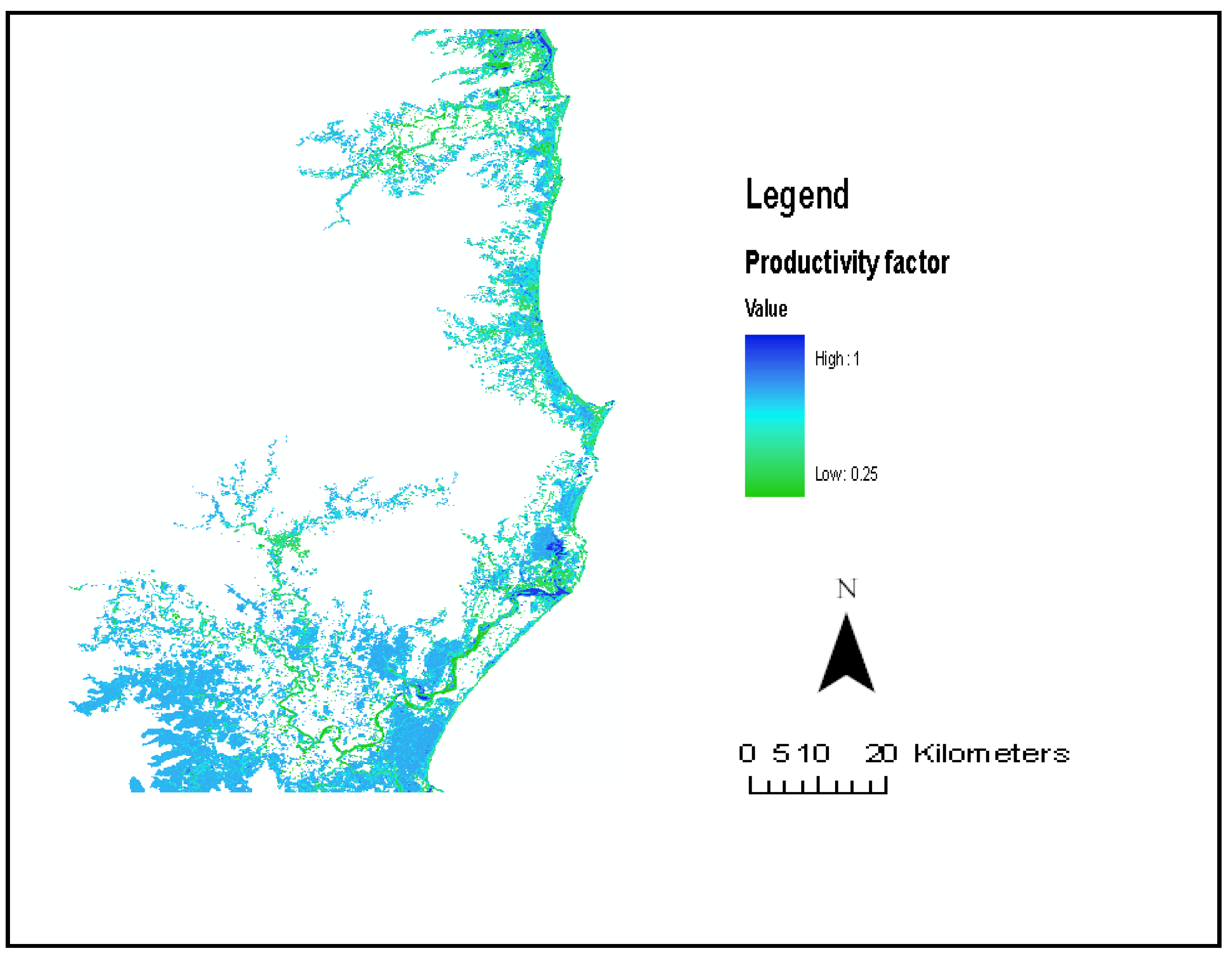
| Wetland class | Mean Productivity factor and SE |
| Mangroves and saltmarshes | 1.00 ± 0.00 |
| Forested wetlands | 0.73 ± 0.04 |
| Coastal swamps | 0.75 ± 0.70 |
| Estuarine water bodies | 0.95 ± 0.07 |
| Coastal upland water bodies | 0.25 ± 0.00 |
| Dunal wetlands | 0.39 ± 0.13 |
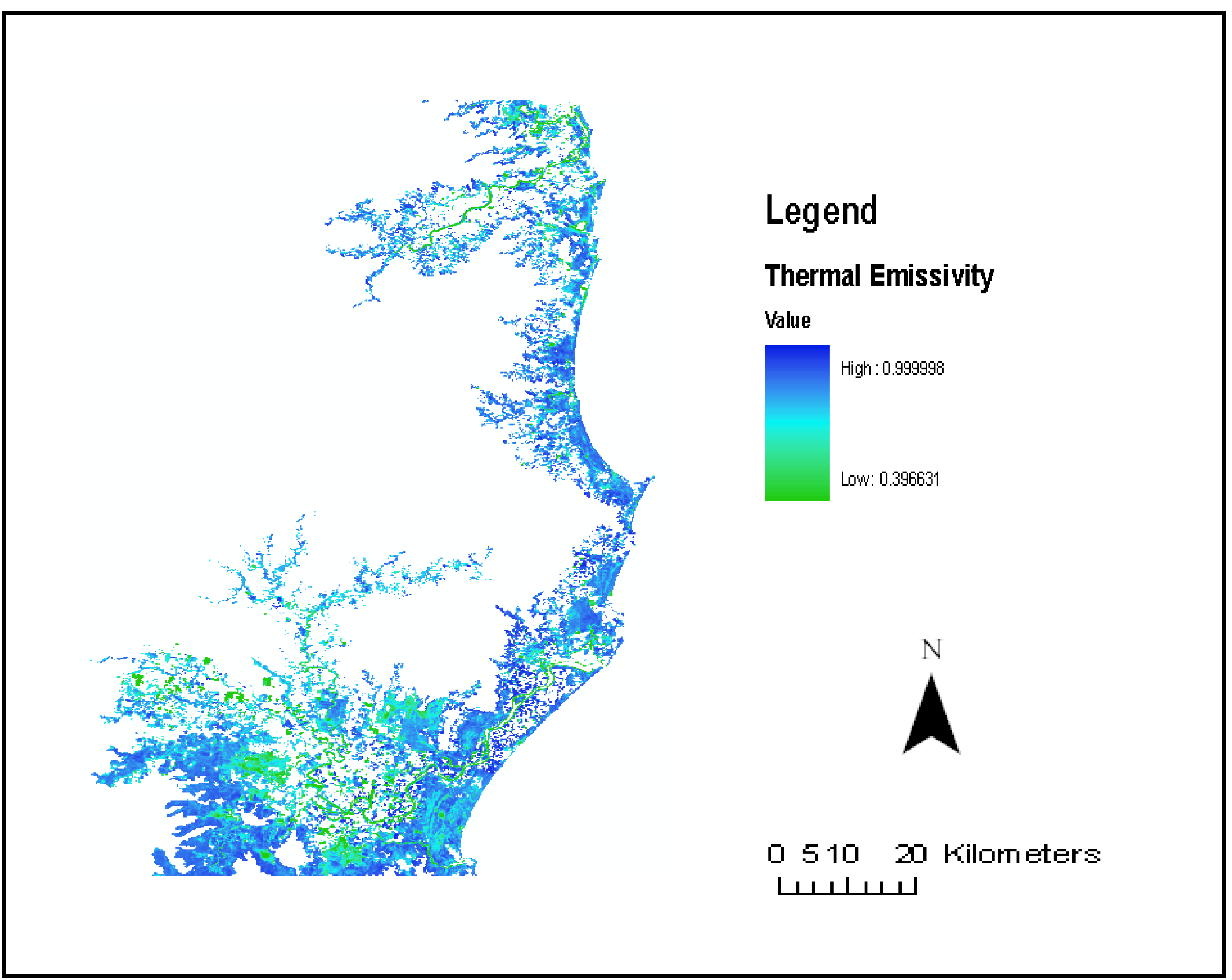
| Producer’s Accuracy | User’s Accuracy | Overall Accuracy | Overall Kappa Statistics | |
| D = Dunal wetlands | 85.19% | 90.20% | ||
| F = Forested wetlands | 79.59% | 78.00% | ||
| S = Coastal swamps | 84.62% | 83.02% | ||
| L = Coastal upland water bodies | 89.58% | 86.00% | ||
| M = Mangroves and saltmarshes | 98.03% | 96.15% | ||
| E = Estuarine water bodies | 87.93% | 91.07% | ||
| 87.50% | 85.00% |
| Wetland type | Area covered by wetland (km2) | Methane emission estimate in June (Tg) ± SE | Methane emission estimate (Tg) in June assuming a 1 °C rise in mean annual temperature ± SE |
| Mangroves and saltmarshes | 36.56 | 0.000013 ± 0.000006 | 0.000018 ± 000008 |
| Forested wetlands | 152.09 | 0.0016 ± 0.00009 | 0.0022 ± 0.0001 |
| Coastal upland water bodies | 32.74 | 0.0000019 ± 0.0000005 | 0.0000037 ± 0.0000007 |
| Estuarine water bodies | 35.97 | 0.000024 ± 0.0000001 | 0.000034 ± 0.0000001 |
| Coastal swamps | 150.56 | 0.00031 ± 00002 | 0.00044 ± 0.00001 |
| Dunal wetlands | 73.37 | 0.000022 ± 0.000008 | 0.000031 ± 0.00001 |
| Total | 481.29 | 0.0019 ± 0.0001 | 0.0027 ± 0.0002 |
4. Discussion
5. Conclusions
Acknowledgements
References
- What Are Wetlands? Ramsar Convention of Wetlands; Information Paper No. 1; Ramsar, Iran, 1971a.
- Mortsch, L.D. Assessing the impact of climate change on the great lakes shoreline wetlands. Climate Change 1998, 40, 391–416. [Google Scholar] [CrossRef]
- Hein, R.; Crutzen, P.J.; Heimann, M. An inverse modelling approach to investigate the global atmospheric methane cycle. Global Biogeochem. Cycle. 1997, 11, 43–76. [Google Scholar] [CrossRef]
- IPCC. Climate Change 2007. The Physical Science Basis; Contribution of Working Group I to the Fourth Assessment Report of the Intergovernmental Panel on Climate Change, Cambridge University Press: Cambridge, UK and New York, NY, USA, 2007. [Google Scholar]
- IPCC. Climate Change 2001. The Scientific Basis; Contribution of Working Group I to the Third Assessment Report of the International Panel on Climate Change, Cambridge University Press: Cambridge, UK, 2001. [Google Scholar]
- Lelieveld, J.; Crutzen, P.J.; Dentener, F.J. Changing concentration, lifetime and climate forcing of atmospheric methane. Tellus Series B 1998, 50, 128–150. [Google Scholar] [CrossRef]
- Hamazaki, T.; Kaneko, Y.; Kuze, A. Carbon dioxide monitoring from the GOSAT satellite. In Proceedings XXth ISPRS Conference, Istanbul, Turkey, 12–23 July 2004; p. 3.
- Asner, G.P. Cloud cover in Landsat observations of the Brazilian Amazon. Int. J. Remote Sens. 2001, 22, 3855–3862. [Google Scholar] [CrossRef]
- Baker, C.; Lawrence, R.; Montagne, C.; Patten, D. Mapping wetlands and riparian areas using Landsat Etm+ Imagery and decision-tree-based models. Wetlands 2006, 26, 465–474. [Google Scholar] [CrossRef]
- Lowry, J.; Hess, L.; Rosenqvist, A. Mapping and monitoring wetlands around the world using ALOS PALSAR: The ALOS kyoto and carbon initiative wetlands. In Innovations in Remote Sensing and Photogrammetry; Jones, S., Reinke, K., Eds.; Springer: Berlin/Heidelberg, Germany, 2009. [Google Scholar]
- Lucas, R.M.; Bunting, P.; Clewley, D.; Proisy, C.; Filho, P.W.M.S.; Woodhouse, I.; Ticehurst, C.; Carreiras, J.; Rosenqvist, A.; Accad, A.; Armston, J. Characterisation and Monitoring of Mangroves Using ALOS PALSAR Data; K&C Phase-1 Report; ALOS K&C: Kyoto, Japan, 2009. [Google Scholar]
- Allen, D.E.; Dalal, R.C.; Rennenberg, H.; Meyer, R.L.; Reeves, S.; Schmidt, S. Spatial and temporal variation of nitrous oxide and methane flux between subtropical mangrove sediments and the atmosphere. Soil Biol. Biochem. 2007, 39, 622–631. [Google Scholar] [CrossRef]
- Bohn, T.J.; Lettenmaier, D.P.; Sathulur, K.; Bowling, L.C.; Podest, E.; McDonald, K.C.; Friborg, T. Methane emissions from western Siberian wetlands: heterogeneity and sensitivity to climate change. Environ. Res. Lett. 2007, 2. [Google Scholar] [CrossRef]
- Liu, Y. Modelling the Emission of Nitrous Oxide (N2O) and Methane (CH4) from The Terrestrial Biosphere to the Atmosphere; Report No. 10; MIT Joint Program on the Science and Policy of Global Change: Cambridge, MA, USA, 1996. [Google Scholar]
- Xu, H.; Cai, Z.C.; Tsuruta, H. Soil moisture between rice-growing seasons affects methane emission, production, and oxidation. Soil Sci. Soc. Amer. J. 2003, 67, 1147–1157. [Google Scholar] [CrossRef]
- Kreuzwieser, J.; Buchholz, J.; Rennenberg, H. Emission of methane and Nitrous Oxide by Australian Mangrove Ecosystems. Plant Biol. 2003, 5, 423–431. [Google Scholar] [CrossRef]
- Kingsford, R. GIs of wetlands in the Murray-Darling Basin. WetlandCare Australia: Ballina, Australia. Available online: http://www.wetlandcare.com.au/Content/templates/research_detail.asp?articleid=106&zoneid=17 (accessed on 3 March, 2010).
- Agarwal, R.; Garg, J.K. Methane emission modelling using MODIS thermal and optical data: A case study on Gujarat. J. Indian Soc. Remote Sens. 2007, 35. [Google Scholar] [CrossRef]
- Takeuchi, W.; Tamura, M.; Yasuoka, Y. Estimation of methane emission from West Siberian wetland by scaling technique between NOAA, AVHRR and SPOT HRV. Remote Sens. Environ. 2003, 85, 21–29. [Google Scholar] [CrossRef]
- Hennessy, K.; Page, C.; McInnes, K.; Jones, R.; Bathols, J.; Collins, D.; Jones, D. Climate Change in New South Wales; Consultancy Report for the New South Wales Greenhouse Office, New South Wales Greenhouse Office: Sydney, NSW, Australia, 2004. [Google Scholar]
- Hilbert, D.W.; Ostendorf, B.; Hopkins, M.S. Sensitivity of tropical forests to climate change in the humid tropics of north Queensland. Austral Ecol. 2001, 26, 590–603. [Google Scholar] [CrossRef]
- Morand, D.T. Soils Landscapes of the Woodburn 1:100,000 Sheet Map; Department of Land and Water Conservation: Sydney, NSW, Australia, 2001.
- Morand, D.T. Soils Landscapes of the Lismore-Ballina 1:100,000 Sheet Map; Department of Land and Water Conservation: Sydney, NSW, Australia, 1994.
- Morand, D.T. Soils Landscapes of the Murwillumbah-Tweed Heads 1:100,000 Sheet Map; Department of Land and Water Conservation: Sydney, NSW, Australia, 1996.
- BOM. Climate statistics for Australian Locations. Available online: http://www.bom.gov.au/climate/averages/tables/cw_058065.shtml (accessed on 28 March, 2010).
- Green, D.L. Wetland classification. In Wetland Management Technical Manual: Wetland Classification; Ecological Services Unit: Sydney, NSW, Australia, 1997. [Google Scholar]
- Van de Griend, A.A.; Owe, M. On the relationship between thermal emissivity and the normalized difference vegetation index for natural surfaces. Int. J. Remote Sens. 1993, 14, 1119–1131. [Google Scholar] [CrossRef]
- Burrows, J.P.; Blyth, E.; Buchwitz, M.; Schneising, O. Methane from boreal wetlands: some issues. Available online: http://dup.esrin.esa.int/stse/files/news/J.%20Burrows%20-%20Methane%20from%20Boreal%20Wetlands%20-%20Some%20Issues.pdf (accessed on 3 March, 2010).
- Sheppard, J.C.; Westberg, H.; Hopper, J.F. Inventory of global methane sources and their production rates. J. Geophys. Res. 1982, 87, 1305–1312. [Google Scholar] [CrossRef]
- Mather, P.M. Computer Processing of Remotely-Sensed Images, 2nd ed.; John Wiley and Sons: Chichester, England, 1999. [Google Scholar]
- Archard, F.; D’Souza, G. Collection and Pre-Processing of NOAA-AVHRR 1 km Resolution Data for Tropical Forest Resource Assessment; Report EUR 16055; European Commission: Luxembourg, 1994. [Google Scholar]
- Eva, H.; Lambin, E.F. Burnt area mapping in Central Africa using ATSR data. Int. J. Remote Sens. 1998, 19, 3473–3497. [Google Scholar] [CrossRef]
- Ozesmi, S.L.; Bauer, M.E. Satellite remote sensing of wetlands. Wetlands Ecology Management 2002, 10, 381–402. [Google Scholar] [CrossRef]
- Congalton, R.G.; Green, K. Assessing the Accuracy of Remotely Sensed Data: Principles and Practices; Lewis Publishers, CRC Press: Boca Raton, FL, USA, 1999. [Google Scholar]
- Campbell, J.B. Introduction to Remote Sensing, 4rd ed.; Guilford Press: New York, NY, USA, 2006. [Google Scholar]
- LPSO. Landsat 7 Science Data User’s Handbook; Landsat Project Science Office, NASA: Greenbelt, MD, USA. Available online: http://landsathandbook.gsfc.nasa.gov/handbook/handbook_toc.html (accessed on 12 August, 2009).
- Snyder, W.C.; Wan, Z.; Zhang, Y.; Feng, Y.Z. Classification based emissivity for land surface temperature measurement from space. Int. J. Remote Sens. 1998, 19, 2753–2774. [Google Scholar] [CrossRef]
- Dinh, H.T.M.; Trung, L.V.; Van, T.T. Surface emissivity in determining land surface temperature. In The International Symposium on Geoinformatics for Spatial-Infrastructure Development in Earth and Applied Sciences(GIS-IDEAS), Vietnam, 9–11 November, 2006.
- Wang, Y.; Wang, Y. Quick measurement of CH4, CO2, and N20 emissions from a short plant ecosystems. Adv. Atmos. Sci. 2003, 20, 842–844. [Google Scholar]
- Cronk, J.K.; Fennessy, M.S. Wetland Plants: Biology and Ecology; Lewis Publishers: New York, NY, USA, 2001. [Google Scholar]
- Purvaja, R.; Ramesh, R. Natural and anthropogenic methane emission from coastal wetlands of South India. Environ. Manag. 2001, 27, 547–557. [Google Scholar] [CrossRef]
- Lovely, D.R.; Klug, M.J. Sulphate reducers can outcompete methangens at fresh water sulphate concentrations. Appl. Environ. Microbiol. 1983, 45, 187–192. [Google Scholar]
- Abram, J.W.; Nedwell, D.B. Hydrogen as a substrate for methanogenesis and sulphate reduction in anaerobic saltmarsh sediment. Arch. Microbiol. 1978, 117, 89–92. [Google Scholar] [CrossRef] [PubMed]
- Verma, A.; Subramanian, V.; Ramesh, R. Methane emission from coastal lagoon:Vembanad lake, west coast India. Chemosphere 2002, 47, 883–889. [Google Scholar] [CrossRef]
© 2010 by the authors; licensee MDPI, Basel, Switzerland. This article is an Open Access article distributed under the terms and conditions of the Creative Commons Attribution license (http://creativecommons.org/licenses/by/3.0/).
Share and Cite
Akumu, C.E.; Pathirana, S.; Baban, S.; Bucher, D. Modeling Methane Emission from Wetlands in North-Eastern New South Wales, Australia Using Landsat ETM+. Remote Sens. 2010, 2, 1378-1399. https://doi.org/10.3390/rs2051378
Akumu CE, Pathirana S, Baban S, Bucher D. Modeling Methane Emission from Wetlands in North-Eastern New South Wales, Australia Using Landsat ETM+. Remote Sensing. 2010; 2(5):1378-1399. https://doi.org/10.3390/rs2051378
Chicago/Turabian StyleAkumu, Clement E., Sumith Pathirana, Serwan Baban, and Daniel Bucher. 2010. "Modeling Methane Emission from Wetlands in North-Eastern New South Wales, Australia Using Landsat ETM+" Remote Sensing 2, no. 5: 1378-1399. https://doi.org/10.3390/rs2051378





